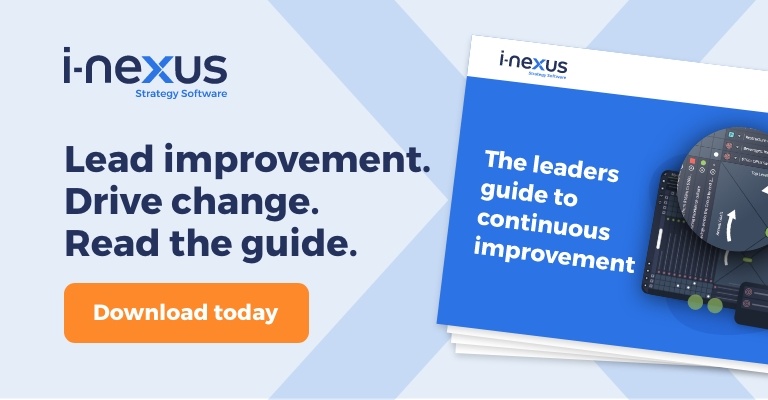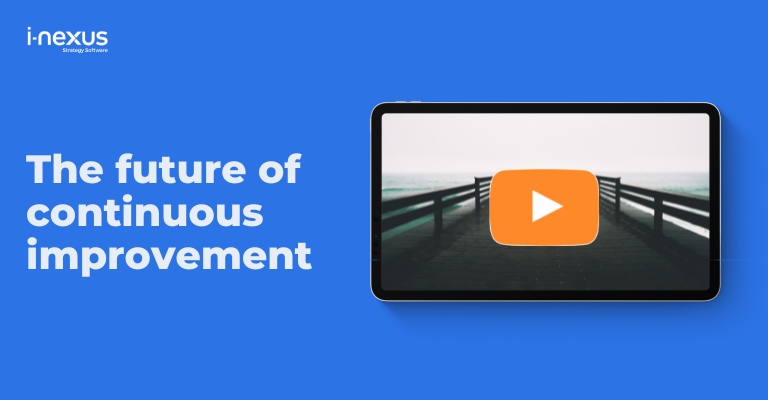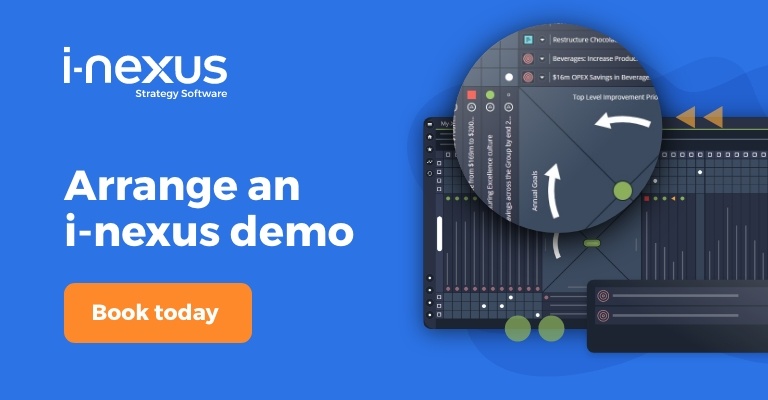Lay the foundations for excellence with this list of top continuous improvement resource across the web, from videos and templates to tools and case studies.
Written by: James Milsom, Head of Marketing
Continuous improvement (CI) is an unwavering commitment to excellence for your organization.
CI, or sometimes known as Kaizen, describes a set of processes and a mindset that constantly seeks to improve products, services and operations, adopted across a broad spectrum of industries.
Ultimately, it has been formalized via the increasingly popular Lean and Agile methodology, which are used worldwide to help organizations streamline work, reduce waste and improve performance.
What is continuous improvement?
Whilst this may be obvious to many, there is nothing wrong with a refresh or starting point, no matter where you are on your journey.
To that end, our eBook 'The Beginners Guide to Continuous Improvement' is the perfect companion on your journey to operational excellence, and covers standard definitions of improvement frameworks, compares and contrasts Lean and Six Sigma, and is packed with advice on DMAIC, root cause problem analyses, stakeholder engagement and more.
Click below for your free copy.
Why is continuous improvement challenging?
Given the effort associated with achieving excellent CI, this aspect of daily business management is difficult. Discipline, or lack thereof, in its routine execution, can derail success.
The challenges with process excellence initiatives and, therefore, reasons to seek out the best resources to support your application are multiple but can be summarized as:
- Changing habitual behavior is complicated, and even with the advent of technologies to support improvements, humans remain at the core of improvement
- A lack of defined objectives around the process and how it supports overall operational excellence
- Difficulties in prioritization of competing initiatives
- Minimal transparency and accountability
- Traditional applications of continuous improvement struggle to adapt to today's economy, specifically the rise of knowledge workers and a non-standardized approach to work, which inherently makes applying CI to processes difficult.
The principles of continuous improvement can be learned through many resources, as well the means to overcome challenges.
Read on for our recommended continuous improvement resources to help your organization succeed in 2024 and beyond.
The Lean Startup
You need this book if you are searching for a CI resource grounded in modern business.
The Lean Startup is one of the best resources for understanding continuous improvement applications in business. Likewise, it is an example of placing the customer at the heart of CI and feeding operational excellence.
Authored by Harvard Business School Entrepreneur-in-Residence, Eric Ries, the Lean Startup challenges readers’ perception of their business and processes while aligning this with the view of your customers.
The Gemba Academy
The Gemba Academy offers expertly curated video tutorials on continuous improvement and its building blocks. It debunks Kaizen, talks about the Toyota Product System and unpicks concepts such as the 5S system.
One noteworthy resource is Gemba Academy’s explanation of the Gemba Walk, a highly valuable tool to embed into your application of CI.
In Gemba Academy’s video (see below), viewers are educated around the value of engaging leaders in daily operations. This ensures the definition and monitoring of CI objectives in practice:
Continuous improvement, Lean and Six Sigma Excel templates
No list of resources is complete without a handy list of Excel templates to use every day to drive your improvements.
Here's a list to get started with:
Deming's Plan Do Check Act cycle
A quick way of implementing continuous improvement is to use Deming’s Plan Do Check Act (PDCA) cycle.
Tying into Kaizen theory, the PDCA cycle offers a systematic approach for testing different ideas and hypotheses.
Deming’s process gives a structured (and understandable) framework for continuous improvement for everyone in your organization to follow - regardless of their level or business unit.
Each step of the PDCA cycle feeds into CI:
- Plan: Define your strategic goals and map out how you’ll achieve them.
- Do: Implement your plan.
- Check: Assess the results of your plan and understand any improvements that can be made.
- Act: Adjust based on your findings from ‘Check’.
When it comes to the application of continuous improvement and PDCA, as with many issues in life, it pays to look towards examples for inspiration.
To that end, we recommend Bright Hub PM’s PDCA implementation examples list to find inspiration around Deming’s cycle. Additionally, it provides information on how to ensure your application is successful.
Creating a Kaizen culture
The second book in our recommended list of process improvement resources is Miller et. al’s ‘Creating a Kaizen Culture’. Miller speaks clearly, and with authority, about culture with regards to relentless and successful continuous improvement.
Within you will find the 10 principles of Kaizen. These include finding solutions in mistakes and letting go of assumptions, which are core to creating a culture and processes where improvement can result.
More importantly, the workbook delivers a blend of personal narratives and scholarly work around Kaizen. This makes it a suitable resource for experienced CI practitioners and those less familiar with the inner workings or principles of continual improvement.
The Toyota Kata
Mike Rother's Toyota Kata concept originated from observing the unique behavior patterns at Toyota and its production system.
In his seminal ‘Toyota Kata’ and ‘Toyota Kata Practice Guide’ books, Rother explores the science of CI and connecting it to human behavior in the workplace.
He noted that ‘Katas’ were a key contributor to Toyota’scontinuous improvement culture.
Katas are the bringing to life of small routines through practice, as opposed to learning by memorizing.
The Kata is a protocol to ensure that knowledge and best practice can be transferred in your organization.
Two Katas are fundamental to Toyota’s improvement culture:
- Problem solving: Here the focus is on one issue or improvement priority at a time, with swiftness of problem-solving at the core of the Kata
- Coaching: Improvement is fundamentally bottom up, achieved through leaders offering guidance on how to resolve problems in the best way
Katas are important for business leaders regarding continual improvement as they are ingredients for a culture of growth and learning.
Katas do, however, require leaders to take ownership when an issue is noted, and give short-term corrective action whilst a long-term solution is realized.
Likewise, leaders are required to understand the origins of problems in the process, its wider effect on the organization, and use the challenge as an improvement opportunity.
Crucially, Rother’s insights identify why organizations fail with CI and how to integrate improvement as a tangible part of your workplace culture.
Indeed, Rother’s keynote at the 2018 Canadian Lean Conference about the Katas is required viewing:
The Three Ms
Continuing the theme of the Toyota Production System, the topic of waste is prevalent in its approach.
When making efficient and effective use of resource, Toyota focus on the three Ms - Muri, Mura, and Muda. These refer to three potential problems for organizations, which are:
- Muri: Overburden through a lack of resources or poor planning.
- Mura: Unevenness or irregularities - usually linked to waste.
- Muda: Waste such as excess transport, inventory, overproduction, or defects.
Toyota’s Kaizen provides ample inspiration for continuous improvement best practice.
To learn more about its processes, read ‘The Toyota Way to Continuous Improvement’.
And as the Toyota Product System continues to evolve, for more advanced readers we recommend reading Joseph Paris’ ‘The Toyota Production System is not enough’ article to explore the future use of Toyota’s practices.
Continuous improvement in the Fourth Industrial Revolution
As organizations embrace Industry 4.0 and the transformation required to remain competitive, reading PwC’s ‘What would continuous improvement look like in the Industry 4.0 world?’ is required reading for those who are conscious of the need to adapt to changing times.
The article explores how CI needs to be in lockstep with modern working.
At its core, the piece examines how CI and Industry 4.0 can converge to the benefit of your organization by using an improved Define, Measure, Analyze, Improve and Control (DMAIC) methodology.
The Lean Six Sigma Pocket Toolbook
For CI practitioners, George et. al's Lean Six Sigma Pocket Toolbook is a go to guide for improving their processes.
Covering 70+ tools associated with saving time and increasing quality, it is an apt inclusion in our list. The toolbook offers techniques for implementing, improving and succeeding with Lean Six Sigma methodology.
Within, you will find:
- Discussion on improving DMAIC, Pull Systems, Control Charts and Pareto Charts
- Recommendation on what tools and techniques to use in particular scenarios, and the reasons why
- Advice on how to properly analyze efforts and to improve upon yesterday's results
Continuous Improvement assessments: The rally-point of the journey
Continuous Improvement, by its very nature, is built on the principle of evolution and learning. In business, we are accustomed to growing our knowledge and skills, and withcontinuous improvement it is no different.
Therefore, Lean Management Journal’s Joseph Paris’ ‘Continuous improvement assessments: The rally-point of the journey’ article is a key part of the puzzle in that regard.
Whether you are embarking upon a CI Journey at your organization, or re-embarking upon the improvement journey, this is the article to read to prepare for success, and more broadly assess your current, and past, Continuous Improvement capabilities.
Digitalizing your process excellence with software
To close, it is worthwhile considering digitalizing your improvement efforts and processes.
Achieving this can come through finding software to manage the end to end of continuous improvement:
- Capturing
- Cascading
- Management
- Measuring
- Improving
With a digital solution, such as i-nexus, you can house yourcontinuous improvement work streams across the whole organization, in one system.
Automated reporting, predictive analytics and an experienced team to embed the software into daily operations is also crucial.
To discover more about how i-nexus can support your continuous improvement initiatives, and connect these to your organization-wide objectives, book a personalized demo of i-nexus today.
Want to learn more about improvement?
To learn more about continuous improvement and operational excellence visit our knowledge hub and explore our resources below:
-
The leader's guide to continuous improvement: Download this eBook to get a comprehensive overview of how DMAIC, Six Sigma, Lean, PDCA can support your business in finding a competitive advantage
-
What does the future of continuous improvement look like?: Your guide to Continuous Improvement in 2020 and beyond.
- The key to strategy execution: Explore the benefits of excellent Strategy Execution, the successful organizations, and how your business can follow suit.
About the author
James is i-nexus’ Head of Marketing. Bringing a passion for strategy from a marketing angle, you’ll find he loves to intertwine sports and strategy. His background covers industries such as energy, broadband, education and employee benefits.
If you’d like to talk more about your strategic challenges, reach out to James on james.milsom@i-nexus.com or connect with James on LinkedIn for more strategic insights.
.






